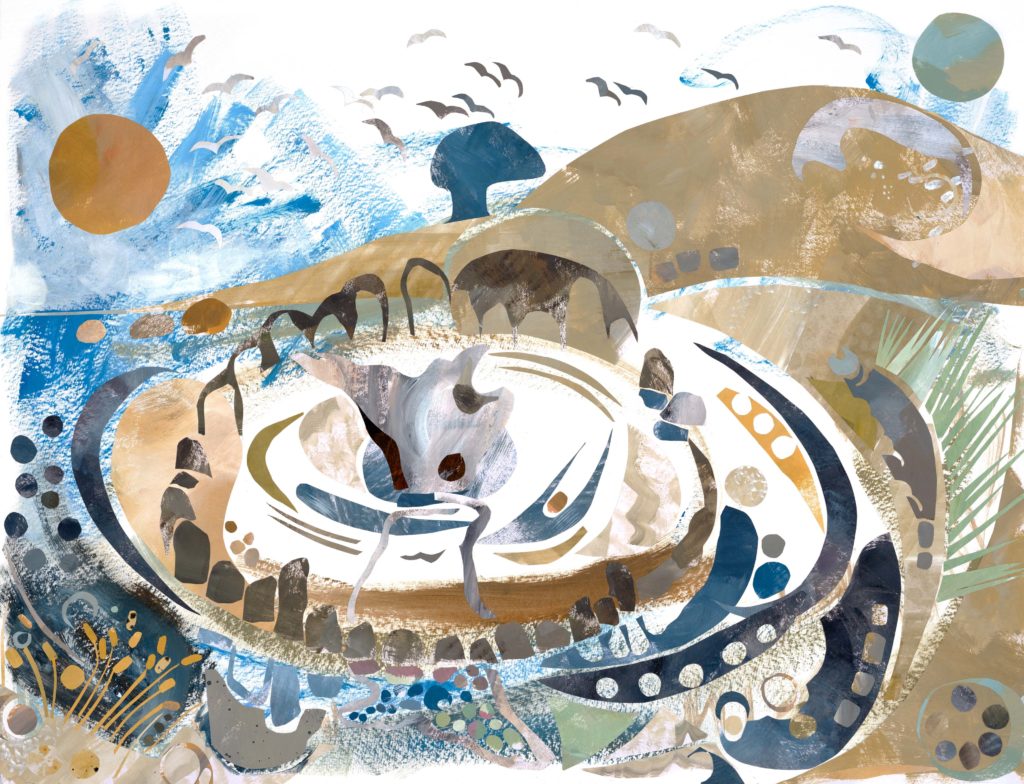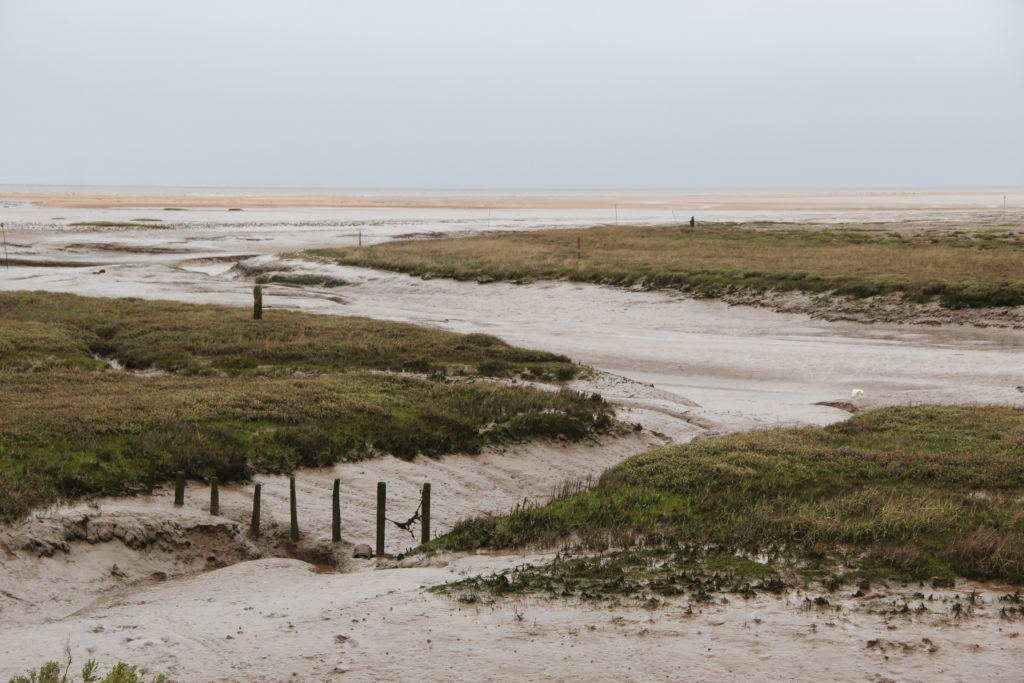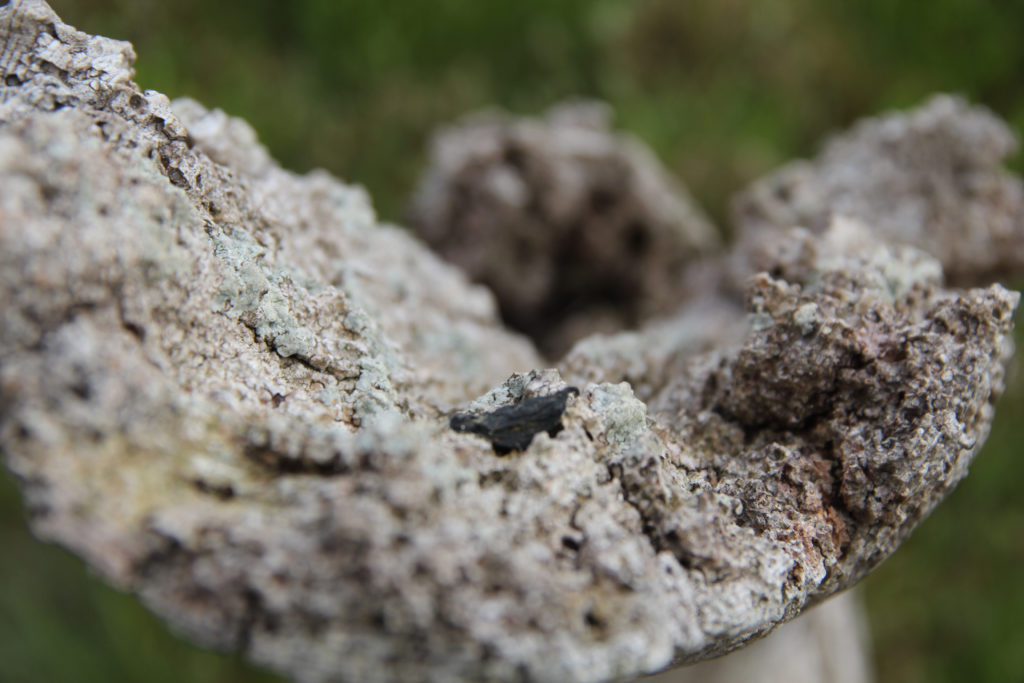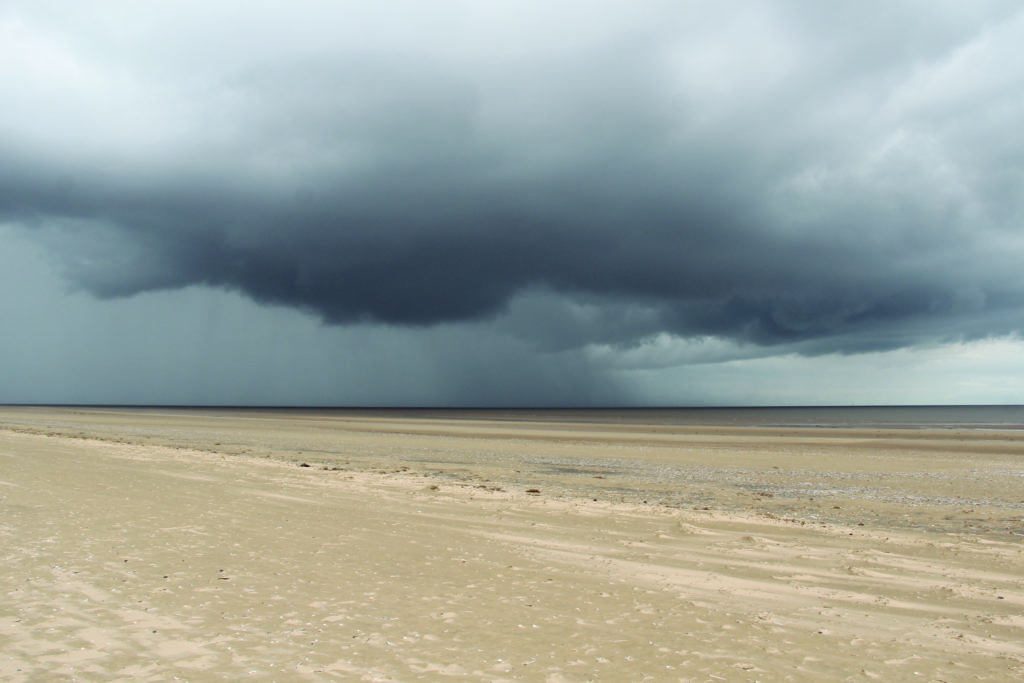‘Half/life’ by Rob St John and Rose Ferraby was created as an installation for Seahenge in ‘The World of Stonehenge’ exhibition at the British Museum. It is released as part of ‘Peace and Plenty’, a new compilation from Blackford Hill. The album is launched to accompany Issue 3 of art and place journal ‘Oscillations’, in which Rose has written about the story of Seahenge and the exciting synergies that can be found between archaeology and art. Here, introducing an extract from her essay, Rose considers Seahenge’s discovery, and the process of representing archaeology through art.

Collage by Rose Ferraby
In the late spring or early summer of 2049BC, an egg-shaped circle of split timbers was erected around a great upturned stump of oak on the fringes of a saltmarsh. A funerary monument to the dead, a woody memorial to a Bronze Age world. 4071 years later, a small selection of the timbers stand vigil at the centre of the World of Stonehenge exhibition at the British Museum. Surrounding them are objects that together begin to tease out the story of British prehistory. It’s a story of connections, of innovation and curiosity. A story of humanity, in all its different forms.
Rapidly dubbed Seahenge by the press, the timber monument was discovered in 1998 at Holme-next-the-Sea on the North Norfolk coast. Caught between high and low tide, the peat beds that had preserved the wood for millennia were exposed to the waves. A year later, archaeologists began the difficult process of excavation. They worked in the few hours between the tides, bailing water and sea creatures from the circle before carefully exposing, recording and removing each timber from the oozing mud. The timbers, heavy with water and age, were taken from the beach on stretchers, each intimately known by those who had dug them. This attentive excavation seemed to echo the monument’s construction; a close community formed or reinforced through tacit, material intimacy, and a shared goal.

I remember watching the excavation of Seahenge on Time Team before I headed off to university to study archaeology. The camaraderie, the mud, all added to my excitement that one day I too might get to be involved in that world where the past emerges at our fingertips. Two decades on, Seahenge came back into my life. Dr Neil Wilkin, curator of Neolithic and Bronze Age archaeology at the British Museum, was planning a new exhibition on British prehistory: ‘The World of Stonehenge’. At its heart would be Seahenge, and Neil was interested in how creative practice might be woven into its display to help enhance a sense of its original landscape setting, its monumental form and the dense nest of humanity held within its timbers.
As an archaeologist and artist, I’ve long been interested in how we can tell the myriad stories that dwell in our investigations in the earth: the subtle ways of seeing that emerge from untangling time in landscape. Exploring archaeological and contemporary stories of Seahenge through creative practice revealed the rich potential that making art around archaeology has in drawing landscapes and shifting time into the gallery; in finding ways of letting audiences feel and sense differently about the past. And the process of making, of attentively approaching an archaeological landscape, has a deep influence about the way I think through the often visceral way we interact with the past.

The beginning of any project is a matter of feeling your way, working instinctively. In my early expeditions to the marshes I took my camera and Rob’s bag of sound recording equipment, and began the intense process of looking and listening. How could I capture not just this place, but a sense of this place over 4000 years ago? I dipped hydrophones in marshy pools, crept along with binaurals to capture the bottle-hoot of a bittern in the reeds. As I stood listening, I was also honing in the visual palette of place: the buff windblown colours, the greyish yellow sediments, the way the wind blew sand down the beach, the ruffle of water by an old wooden stump. The slowness required of filming and sound recording gives time for getting really immersed in a landscape, and the constant desire to go a bit further, find the next thing, often leads to unexpected discoveries.
After my first visit to the coast, I began the process of talking to the archaeologists involved in the discovery and excavation of Seahenge. Their stories folded into one another, each bringing aspects of the story to life. And in talking to them I was reminded that there exists within archaeology an empathy, a kindness that accompanies the act of uncovering other lives and memories in the landscape. It became clear that the process of excavation echoed that of the monuments construction in so many little ways, and how thoughtful the archaeologists were of the people who had gone before them.

Wrapping these voices and stories into the landscapes and material forms of the film and audio now began. Rob St John then took the archive of sound recordings, and we talked about how to create a sound piece for the exhibition which gave a sense of the landscape and materiality of the monument through time. Rob variously warped, eroded, abstracted and recomposed the recordings of the Norfolk coastline into new sonic tones and textures. His ten-minute composition used techniques of granular synthesis and environmentally-altered tape loops, bringing resonant processes of ecological chance and uncertainty into its production. The resulting sound piece is installed across multiple speakers around the timbers of Seahenge creating a subtle sonic environment throughout the British Museum gallery.
Rob’s composition also soundtracks the Seahenge film, which aims to bring story and contextualise the monument in a more abstract, artistic form. The film’s narrative is created by the voices of the archaeologists involved, and the imagery draws on the coastal palette, pulling in and out of focus between small details and broad views. Finally, a painted collage grew from the quiet recollections of the landscape and memories recounted to me of the excavation; a slow layering of paper to echo the ever changing come and go of that prehistoric coastal world. Between them, it’s hoped that these artworks bring new ways of imagining Seahenge, of understanding the narratives of people and place that live with it.
*
The rest of Rose’s essay can be found in Oscillations Issue 3, published later in July by Random Spectacular. Peace and Plenty is out now from Blackford Hill, and can be purchased here, or comes free with pre-orders of Oscillations.
‘The World of Stonehenge’ exhibition at the British Museum closes on the 17th July 2022.
Rose Ferraby is an artist and archaeologist based in North Yorkshire. Her work often explores our relationship with landscape, roving between research and excavations to creative practice and broadcasting. Her series on archaeology ‘EarthWorks’ for Radio 3 is available here [https://www.bbc.co.uk/programmes/m0015v2l/episodes/player]. Her work has also formed part of archaeological exhibitions at the Museum of Archaeology & Anthropology, Cambridge and the Weston Park Museum, Sheffield.
Rob St John is an artist and writer based in rural Lancashire. His practice is focused on the blurrings of nature and culture in contemporary landscapes. He works primarily across sound, moving image, installation and film photography and has been shown at Tate Modern, the V&A, the Barbican and many more.